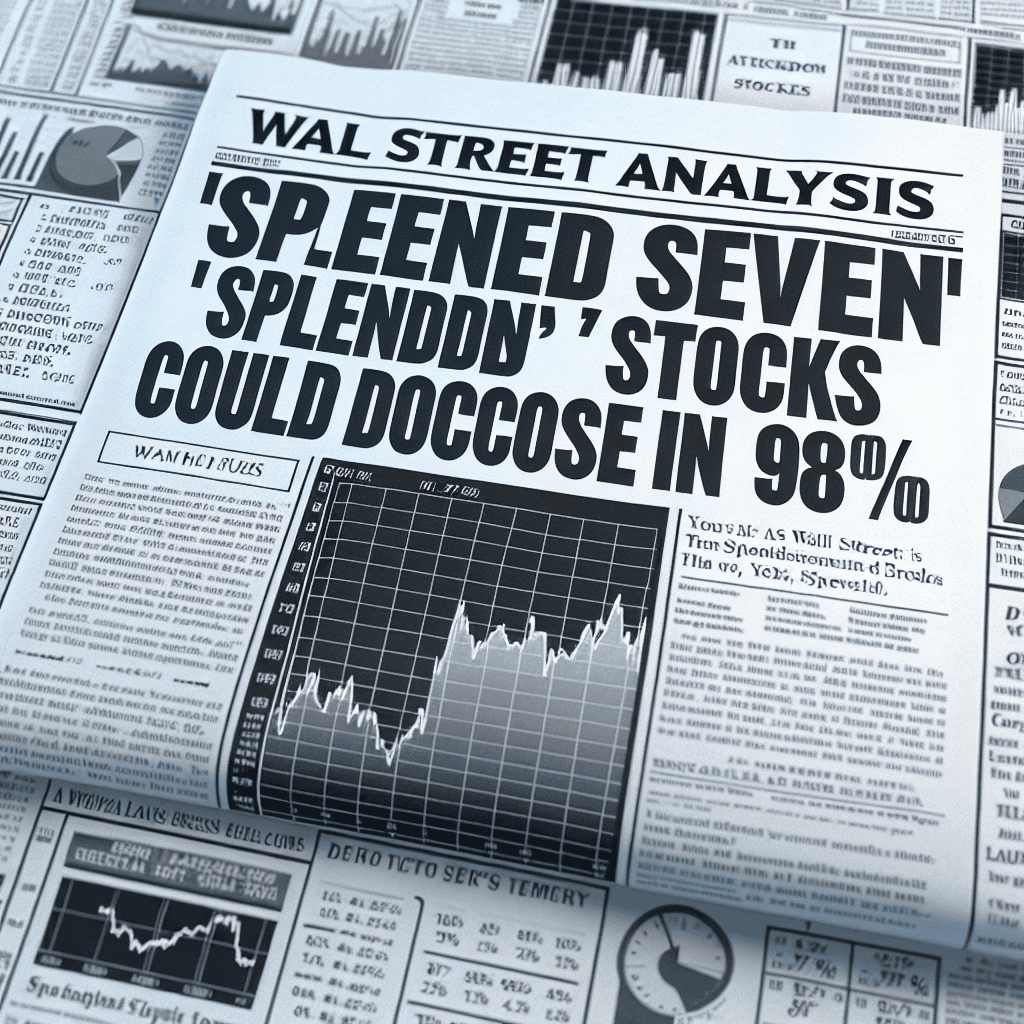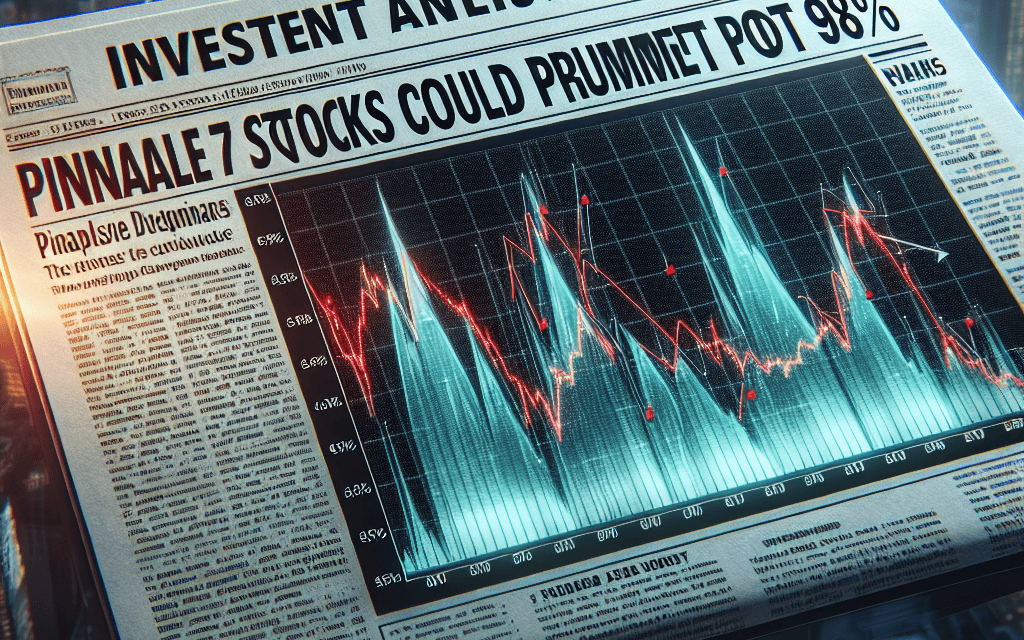“Brace for Impact: ‘Magnificent Seven’ Stocks Teeter on the Edge of a 98% Plunge”
Introduction
In recent financial analyses, Wall Street experts have issued a stark warning regarding the potential volatility of the so-called “Magnificent Seven” stocks, suggesting that these high-flying equities could face a dramatic downturn of up to 98%. This cautionary outlook comes amid growing concerns over inflated valuations, market corrections, and broader economic uncertainties. The “Magnificent Seven,” a group of tech giants that have driven significant market gains, are now under scrutiny as analysts evaluate the sustainability of their current valuations in the face of potential regulatory challenges, interest rate hikes, and shifting investor sentiment. As these stocks have become pivotal in shaping market trends, their potential decline could have far-reaching implications for both individual portfolios and the broader financial landscape.
Understanding the Magnificent Seven: A Deep Dive into the Stocks at Risk
In recent months, the financial world has been abuzz with discussions surrounding the so-called “Magnificent Seven” stocks, a group of high-performing equities that have captured the attention of investors and analysts alike. These stocks, which include some of the most prominent names in the technology and consumer sectors, have experienced remarkable growth, leading to significant market capitalization and widespread investor enthusiasm. However, despite their impressive performance, Wall Street experts are now sounding the alarm, cautioning that these stocks could face a dramatic downturn, with potential losses reaching as high as 98%.
To understand the gravity of these warnings, it is essential to first examine the composition of the Magnificent Seven. This group typically includes industry giants such as Apple, Amazon, Alphabet, Microsoft, Meta Platforms, Tesla, and Nvidia. These companies have been at the forefront of innovation, driving technological advancements and reshaping consumer behavior. Their dominance in their respective fields has not only propelled their stock prices to new heights but has also contributed significantly to the overall performance of major stock indices.
However, the very factors that have fueled their meteoric rise may also be the harbingers of their potential decline. One of the primary concerns raised by analysts is the overvaluation of these stocks. As investors have flocked to these companies, their valuations have soared to levels that some experts argue are unsustainable. This overvaluation is particularly concerning in an environment where interest rates are rising, as higher rates can lead to increased borrowing costs and reduced consumer spending, ultimately impacting corporate earnings.
Moreover, the competitive landscape is rapidly evolving, with new entrants and technological disruptions posing significant challenges to the established players. For instance, in the realm of artificial intelligence and cloud computing, smaller, more agile companies are emerging with innovative solutions that could erode the market share of the Magnificent Seven. Additionally, regulatory scrutiny is intensifying, particularly for tech giants like Meta Platforms and Alphabet, as governments worldwide grapple with issues related to data privacy, antitrust concerns, and misinformation. Such regulatory pressures could result in increased compliance costs and operational constraints, further affecting profitability.
Furthermore, geopolitical tensions and supply chain disruptions continue to pose risks to these companies. The ongoing trade disputes and economic uncertainties have the potential to disrupt global supply chains, leading to production delays and increased costs. For companies like Tesla and Nvidia, which rely heavily on global manufacturing and distribution networks, these disruptions could have a pronounced impact on their bottom lines.
In light of these challenges, Wall Street experts are urging investors to exercise caution and consider the potential risks associated with holding these stocks. While the Magnificent Seven have undoubtedly been instrumental in driving market growth, their future performance is far from guaranteed. Investors are advised to conduct thorough due diligence, diversify their portfolios, and remain vigilant to the evolving market dynamics.
In conclusion, while the Magnificent Seven stocks have been emblematic of the recent bull market, the warnings from Wall Street experts serve as a stark reminder of the inherent risks in equity investing. As the financial landscape continues to shift, it is imperative for investors to stay informed and make prudent decisions to safeguard their investments. The potential for a significant downturn underscores the importance of a balanced and diversified investment strategy, one that can weather the uncertainties of the market and adapt to the ever-changing economic environment.
Historical Precedents: When Wall Street Experts Predicted Major Stock Drops
In the annals of financial history, Wall Street has witnessed numerous instances where experts have sounded alarms about potential stock market downturns. These warnings, often met with skepticism, have sometimes proven prescient, underscoring the importance of heeding expert analysis. The recent cautionary note regarding the so-called “Magnificent Seven” stocks, which include some of the most prominent technology companies, is reminiscent of past episodes where market darlings faced precipitous declines. This historical context provides valuable insights into the dynamics of stock market predictions and the factors that can lead to significant devaluations.
To understand the gravity of the current warnings, it is instructive to look back at similar situations. One notable example is the dot-com bubble of the late 1990s and early 2000s. During this period, technology stocks soared to unprecedented heights, driven by speculative investments and the promise of a digital future. However, as Wall Street experts began to scrutinize the unsustainable valuations and lack of profitability among many tech companies, warnings emerged about an impending crash. These predictions were initially dismissed by many investors, caught up in the euphoria of rapid gains. Yet, as history unfolded, the bubble burst, leading to a dramatic collapse in stock prices, with some companies losing nearly all their market value.
Similarly, the financial crisis of 2008 serves as another poignant reminder of the potential for significant stock market corrections. In the years leading up to the crisis, a housing market boom fueled by subprime mortgages created an illusion of endless growth. However, astute analysts began to identify the underlying risks and issued warnings about the fragility of the financial system. Once again, these warnings were largely ignored until the crisis erupted, resulting in a severe market downturn and the collapse of major financial institutions.
Drawing parallels to these historical precedents, the current warnings about the “Magnificent Seven” stocks suggest that investors should exercise caution. While these companies have demonstrated remarkable growth and innovation, their valuations have reached levels that some experts deem unsustainable. The potential for a 98% drop, as predicted by certain analysts, may seem extreme, yet it highlights the inherent volatility and unpredictability of the stock market. Factors such as regulatory changes, shifts in consumer behavior, and technological disruptions could all contribute to a significant revaluation of these stocks.
Moreover, the interconnectedness of global markets means that a downturn in these high-profile stocks could have broader implications for the financial system. As seen in past crises, the ripple effects of a major stock market correction can extend beyond individual companies, impacting investor confidence and economic stability. Therefore, it is crucial for investors to remain vigilant and consider the potential risks alongside the rewards.
In conclusion, while the prediction of a 98% drop in the “Magnificent Seven” stocks may seem alarming, it serves as a reminder of the cyclical nature of financial markets. Historical precedents demonstrate that expert warnings, though sometimes disregarded, can provide valuable foresight into potential market corrections. As investors navigate the complexities of the current financial landscape, understanding these historical lessons can help inform more prudent investment decisions.
Risk Factors: Why the Magnificent Seven Stocks Are Vulnerable
In recent months, the financial world has been abuzz with discussions surrounding the so-called “Magnificent Seven” stocks, a group of high-performing technology giants that have captured the attention of investors worldwide. However, despite their impressive track records and substantial market capitalizations, Wall Street experts are now sounding the alarm, warning that these stocks could face a precipitous decline of up to 98%. This stark prediction is rooted in a confluence of risk factors that have the potential to undermine the stability and growth prospects of these companies.
To begin with, the Magnificent Seven stocks are not immune to the broader economic challenges that are currently affecting global markets. Rising interest rates, inflationary pressures, and geopolitical tensions are creating an environment of uncertainty that could weigh heavily on these companies. As central banks around the world tighten monetary policy to combat inflation, the cost of borrowing increases, which can lead to reduced consumer spending and slower economic growth. This, in turn, could negatively impact the revenue streams of these tech giants, which are heavily reliant on consumer demand and discretionary spending.
Moreover, the regulatory landscape is becoming increasingly complex and challenging for these technology behemoths. Governments across the globe are scrutinizing the practices of large tech companies more closely, with a particular focus on issues such as data privacy, antitrust concerns, and market dominance. The potential for increased regulation poses a significant risk to the Magnificent Seven, as it could lead to higher compliance costs, legal battles, and even forced divestitures. Such regulatory pressures could erode profit margins and stifle innovation, ultimately affecting the long-term growth trajectories of these firms.
In addition to regulatory challenges, the Magnificent Seven stocks are also facing intensifying competition from both established players and emerging startups. The rapid pace of technological advancement means that these companies must continuously innovate to maintain their competitive edge. However, as new entrants disrupt traditional business models and offer alternative solutions, the market share of these tech giants could be threatened. This competitive pressure necessitates substantial investment in research and development, which could strain financial resources and impact profitability.
Furthermore, the concentration of market power within the Magnificent Seven stocks presents a systemic risk to the broader financial markets. These companies have become integral components of major stock indices, and their performance has a disproportionate impact on market movements. Consequently, any significant downturn in their stock prices could trigger a broader market correction, exacerbating the financial challenges faced by investors and institutions alike. This interconnectedness underscores the vulnerability of these stocks to market volatility and investor sentiment.
Lastly, the valuation levels of the Magnificent Seven stocks have reached unprecedented heights, raising concerns about potential overvaluation. While these companies have delivered impressive growth in recent years, their stock prices have surged to levels that may not be sustainable in the long term. If investor expectations are not met, or if there is a shift in market sentiment, these stocks could experience a sharp correction as investors reassess their valuations.
In conclusion, while the Magnificent Seven stocks have been heralded as leaders in the technology sector, they are not without their vulnerabilities. Economic uncertainties, regulatory challenges, competitive pressures, systemic risks, and valuation concerns all contribute to the potential for a significant decline in their stock prices. As Wall Street experts caution against complacency, investors would be wise to carefully consider these risk factors when evaluating their portfolios.
Investor Reactions: How the Market Responds to Dire Warnings

In recent weeks, Wall Street has been abuzz with discussions surrounding the so-called “Magnificent Seven” stocks, a group of high-performing technology companies that have captured the attention of investors worldwide. However, a dire warning from financial experts has sent ripples through the market, suggesting that these stocks could potentially plummet by as much as 98%. This alarming prediction has prompted a range of reactions from investors, who are now grappling with the implications of such a dramatic downturn.
To begin with, it is essential to understand the context in which these warnings have emerged. The “Magnificent Seven” stocks, comprising industry giants such as Apple, Microsoft, and Amazon, have enjoyed a meteoric rise over the past decade. Their impressive growth has been fueled by technological advancements, strategic acquisitions, and a robust consumer base. Nevertheless, some analysts argue that these stocks are now overvalued, with their current prices reflecting unrealistic expectations of future growth. Consequently, the warning of a potential 98% drop has sparked a wave of concern among investors.
In response to these warnings, the market has exhibited a range of reactions. On one hand, some investors have chosen to adopt a cautious approach, reassessing their portfolios and considering the potential risks associated with holding these stocks. This has led to a noticeable increase in trading activity, as investors seek to mitigate potential losses by diversifying their investments. On the other hand, there are those who remain steadfast in their belief in the long-term potential of these companies, viewing the warnings as an opportunity to buy at a lower price. This divergence in investor sentiment has contributed to heightened volatility in the market, as traders navigate the uncertain landscape.
Moreover, the warnings have also prompted a broader discussion about the sustainability of the current market environment. With interest rates remaining relatively low and inflationary pressures mounting, some experts argue that the market is due for a correction. The potential decline of the “Magnificent Seven” stocks is seen by some as a harbinger of a more significant market adjustment, which could have far-reaching implications for the global economy. As a result, investors are increasingly focused on macroeconomic indicators, such as employment data and central bank policies, to gauge the likelihood of such an event.
In addition to these market dynamics, the warnings have also sparked a debate about the role of technology companies in the broader economy. While these firms have been at the forefront of innovation and have driven significant economic growth, their dominance has raised concerns about market concentration and the potential for regulatory intervention. As governments around the world grapple with issues such as data privacy and antitrust regulations, the future of these companies remains uncertain. This regulatory uncertainty adds another layer of complexity for investors, who must weigh the potential risks and rewards of investing in these stocks.
In conclusion, the warning that the “Magnificent Seven” stocks could drop by 98% has elicited a range of reactions from investors, reflecting the complex interplay of market forces and investor sentiment. As the situation continues to evolve, it is clear that the market’s response will be shaped by a multitude of factors, including macroeconomic conditions, regulatory developments, and the inherent volatility of the stock market. For investors, navigating this uncertain landscape will require a careful balance of risk management and strategic decision-making.
Diversification Strategies: Protecting Your Portfolio from Potential Losses
In the ever-evolving landscape of financial markets, investors are constantly seeking strategies to safeguard their portfolios from potential downturns. Recently, Wall Street experts have raised alarms about the so-called “Magnificent Seven” stocks, suggesting that these high-flying equities could face a precipitous drop of up to 98%. This stark warning underscores the importance of diversification as a critical strategy for protecting one’s investments from significant losses.
The “Magnificent Seven” stocks, which have captured the attention of investors due to their impressive performance, include some of the most prominent names in the technology sector. These companies have experienced substantial growth, driven by innovation and market dominance. However, the very factors that have propelled these stocks to great heights also contribute to their vulnerability. Market analysts caution that over-reliance on a concentrated group of stocks can expose investors to heightened risks, particularly if these companies encounter unforeseen challenges or shifts in market dynamics.
To mitigate such risks, diversification emerges as a prudent approach. By spreading investments across a variety of asset classes, sectors, and geographic regions, investors can reduce their exposure to the volatility of any single stock or market segment. This strategy not only helps in cushioning the impact of potential losses but also enhances the potential for long-term returns. Diversification acts as a buffer, ensuring that the underperformance of one asset does not disproportionately affect the overall portfolio.
Moreover, diversification is not limited to merely holding a mix of stocks. It encompasses a broader spectrum of investment vehicles, including bonds, real estate, commodities, and alternative assets. Each of these asset classes responds differently to economic conditions, thereby providing a hedge against market fluctuations. For instance, while stocks may experience volatility during economic downturns, bonds often offer stability and consistent income. Similarly, real estate and commodities can serve as effective inflation hedges, preserving purchasing power in times of rising prices.
In addition to asset class diversification, sector diversification is equally crucial. By investing in a range of industries, investors can avoid the pitfalls associated with sector-specific downturns. For example, while technology stocks have been the darlings of recent years, other sectors such as healthcare, consumer goods, and energy offer unique growth opportunities and resilience against market shifts. This balanced approach ensures that a portfolio is not overly reliant on the fortunes of a single industry.
Furthermore, geographic diversification provides an additional layer of protection. By investing in international markets, investors can capitalize on growth opportunities outside their home country and reduce exposure to domestic economic challenges. Global diversification allows investors to benefit from varying economic cycles and policy environments, thereby enhancing the overall stability of their portfolios.
In conclusion, while the allure of the “Magnificent Seven” stocks is undeniable, the warnings from Wall Street experts serve as a timely reminder of the inherent risks associated with concentrated investments. Diversification remains a cornerstone of sound investment strategy, offering a robust defense against potential losses. By embracing a diversified approach that spans asset classes, sectors, and geographies, investors can navigate the complexities of financial markets with greater confidence and resilience. As the adage goes, “Don’t put all your eggs in one basket,” and in the world of investing, this wisdom holds true now more than ever.
The Role of Speculation: How Market Hype Can Lead to Overvaluation
In recent years, the stock market has witnessed a surge in speculative investments, driven largely by the allure of high returns and the influence of market hype. This phenomenon has been particularly evident in the case of the so-called “Magnificent Seven” stocks, which have captured the attention of investors and analysts alike. However, Wall Street experts are now sounding the alarm, warning that these stocks could face a dramatic decline, potentially dropping by as much as 98%. This stark prediction underscores the critical role that speculation plays in the overvaluation of stocks and highlights the inherent risks associated with such market dynamics.
Speculation, by its very nature, involves making high-risk investments based on the anticipation of future price movements rather than intrinsic value. This approach can lead to inflated stock prices, as investors pour money into companies with the expectation of continued growth and profitability. The “Magnificent Seven” stocks, which include some of the most prominent technology and innovation-driven companies, have become emblematic of this trend. Their meteoric rise in value has been fueled by a combination of investor enthusiasm, media coverage, and the perception of these companies as leaders in their respective fields.
However, the reliance on speculation can create a precarious situation where stock prices become detached from the underlying fundamentals of the companies. As investors focus on potential future gains, they may overlook critical factors such as earnings, revenue growth, and market competition. This disconnect can result in overvaluation, where stocks are priced significantly higher than their actual worth. In such cases, any negative news or shifts in market sentiment can trigger a rapid decline in stock prices, as investors rush to sell off their holdings.
The warnings from Wall Street experts serve as a reminder of the potential consequences of unchecked speculation. While the “Magnificent Seven” stocks have enjoyed substantial gains, their valuations may not be sustainable in the long term. Factors such as regulatory changes, technological disruptions, and economic downturns could all contribute to a reevaluation of these companies’ prospects, leading to a sharp correction in their stock prices. Moreover, the interconnected nature of the global economy means that external events, such as geopolitical tensions or shifts in monetary policy, could also impact investor confidence and exacerbate market volatility.
To mitigate the risks associated with speculative investments, it is essential for investors to adopt a more disciplined approach to stock selection. This involves conducting thorough research and analysis to assess the true value of a company, rather than relying solely on market sentiment or short-term trends. By focusing on fundamentals such as earnings growth, competitive positioning, and management quality, investors can make more informed decisions and reduce their exposure to potential market downturns.
In conclusion, the warnings from Wall Street experts regarding the “Magnificent Seven” stocks highlight the dangers of speculation and the potential for overvaluation in the stock market. While these stocks have captured the imagination of investors, it is crucial to recognize the risks associated with investing based on hype and speculation. By prioritizing a more analytical and value-driven approach, investors can better navigate the complexities of the market and safeguard their portfolios against the potential for significant losses.
Future Outlook: What a 98% Drop Could Mean for the Stock Market
The financial landscape is often characterized by its unpredictability, and recent warnings from Wall Street experts have added a new layer of concern for investors. The focus of these warnings is the so-called “Magnificent Seven” stocks, a group of high-performing technology companies that have driven much of the market’s recent gains. These stocks, which include industry giants like Apple, Microsoft, and Amazon, have been instrumental in shaping the current market dynamics. However, experts are now cautioning that these stocks could face a dramatic downturn, with potential drops of up to 98%. This stark prediction raises significant questions about the future outlook of the stock market and the broader economic implications.
To understand the potential impact of such a decline, it is essential to consider the role these stocks play in the market. The “Magnificent Seven” have not only been leaders in innovation and growth but have also become integral components of major stock indices. Their performance has a substantial influence on market sentiment and investor confidence. Consequently, a severe drop in their value could trigger a ripple effect, leading to widespread market volatility. This scenario could erode investor wealth, disrupt financial markets, and potentially lead to a broader economic downturn.
Moreover, the potential decline of these stocks could signal a shift in market dynamics. For years, technology companies have been at the forefront of market growth, driven by rapid advancements and consumer demand. However, a significant drop in their stock prices could indicate a saturation point or a shift in investor priorities. This could lead to a reevaluation of investment strategies, with investors seeking opportunities in other sectors that may offer more stability or growth potential. Such a shift could alter the landscape of the stock market, affecting everything from sector performance to the valuation of individual companies.
In addition to market dynamics, the potential drop in the “Magnificent Seven” stocks could have broader economic implications. These companies are not only market leaders but also major employers and contributors to economic growth. A significant decline in their stock prices could impact their ability to invest in new projects, hire employees, and drive innovation. This, in turn, could slow economic growth and reduce consumer confidence, creating a challenging environment for businesses and policymakers alike.
Furthermore, the potential decline of these stocks raises questions about the sustainability of current market valuations. The rapid rise in stock prices over recent years has led to concerns about overvaluation and the possibility of a market correction. A significant drop in the “Magnificent Seven” stocks could be a catalyst for such a correction, prompting a reassessment of stock valuations across the board. This could lead to a more cautious approach from investors, with a focus on fundamentals and long-term growth prospects.
In conclusion, the warnings from Wall Street experts about the potential 98% drop in the “Magnificent Seven” stocks underscore the inherent risks and uncertainties in the stock market. While these predictions are not guaranteed outcomes, they highlight the need for investors to remain vigilant and adaptable in their strategies. The potential impact on market dynamics, economic growth, and investor sentiment underscores the importance of a diversified investment approach and a keen awareness of market trends. As the financial landscape continues to evolve, staying informed and prepared will be crucial for navigating the challenges and opportunities that lie ahead.
Q&A
1. **What are the ‘Magnificent Seven’ stocks?**
The ‘Magnificent Seven’ typically refers to seven major tech companies: Apple, Microsoft, Amazon, Alphabet (Google), Meta Platforms (Facebook), Tesla, and Nvidia.
2. **Why are these stocks at risk of dropping by 98%?**
Analysts warn of overvaluation, potential economic downturns, regulatory challenges, and market corrections as factors that could lead to such a drastic drop.
3. **Who issued the warning about the potential drop?**
The warning was issued by a group of Wall Street experts or analysts, though specific names or firms may vary depending on the report.
4. **What are the potential consequences of such a drop?**
A 98% drop in these stocks could lead to significant losses for investors, impact retirement funds, and cause broader market instability.
5. **Have these stocks shown signs of vulnerability before?**
Yes, these stocks have experienced volatility and corrections in the past, often due to market conditions or company-specific issues.
6. **What should investors do in response to this warning?**
Investors are advised to diversify their portfolios, stay informed about market trends, and consider risk management strategies.
7. **Is there historical precedent for such a drop in major stocks?**
While rare, there have been instances of significant drops in major stocks during market crashes or bubbles, such as the dot-com bubble burst.
Conclusion
The warning from Wall Street experts about the potential 98% drop in the “Magnificent Seven” stocks highlights significant concerns over their current valuations and market conditions. Such a drastic decline would imply that these stocks are significantly overvalued, possibly due to speculative trading or unsustainable growth expectations. Investors should exercise caution, conduct thorough research, and consider diversifying their portfolios to mitigate potential risks associated with these stocks. The warning serves as a reminder of the inherent volatility and unpredictability of the stock market, emphasizing the importance of prudent investment strategies.





